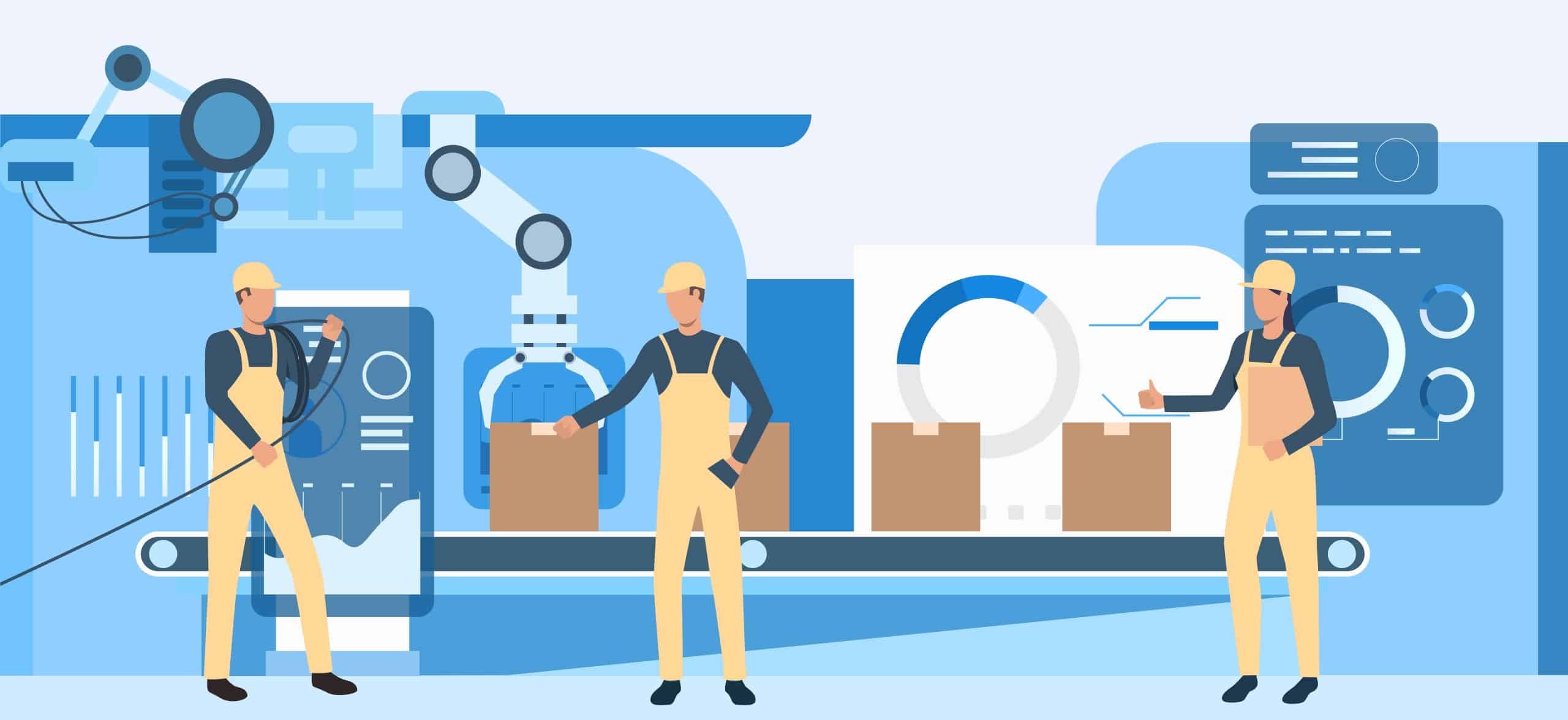What is Closed-Loop Manufacturing?
Closed-loop manufacturing is a cutting-edge method of production that aims to establish a self-sufficient, circular system in which resources and materials are constantly recycled, repurposed, and reused throughout the manufacturing process. In contrast to the conventional linear manufacturing paradigm, which uses raw materials to make products that ultimately end up as trash, closed-loop systems maintain material circulation in an effort to limit waste and use of resources. This technique greatly lessens the industrial industry’s environmental impact while also optimizing resource consumption.
A few essential components are involved in closed-loop manufacturing when it comes to the creation of wet wipes. It starts by giving priority to the use of renewable and sustainable raw resources, including biodegradable fibers, which can be recycled back into the manufacturing cycle after being used once. Second, two essential elements are energy and water efficiency. Water recycling systems, which repurpose and filter production-use water to reduce total water usage, are often included into closed-loop systems. Similar to this, energy is maximized by employing renewable energy sources, such as wind or solar power, which results in an energy loop that reduces emissions and waste.
The recycling and reuse of waste materials and byproducts is a crucial component of closed-loop production. Remaining fibers or scraps from the manufacturing process would normally be thrown away in a conventional system. Closed-loop systems, on the other hand, gather, handle, and repurpose these materials back into the production cycle for the purpose of making fresh wet wipes or other related items like packaging materials. Wet wipes manufacturers may save expenses, lessen their dependency on raw resources, and lessen the overall environmental effect of their operations thanks to this closed cycle.
Closed-loop manufacturing includes the product’s end of life as well. Wet wipes made with this system’s biodegradable ingredients may naturally decompose after use and return to the environment without harming it over time. To further improve the circular nature of the system, some wet wipes manufacturers are even creating systems for collecting old wet wipes, processing them, and then adding the recovered ingredients back into the manufacturing cycle.
Closed-loop manufacturing is essentially an all-encompassing production strategy that promotes sustainability and efficiency while minimizing waste. This technology signifies a substantial change toward more environmentally friendly and conscientious production techniques in the wet wipes business and beyond by continually recycling resources and decreasing environmental effect.
Key Components of Closed-Loop Systems in Wet Wipes Production
1. Sustainable Sourcing of Raw Materials
A key component of closed-loop systems in the manufacturing of wet wipes is the use of renewable and sustainable raw materials. Historically, synthetic, non-biodegradable materials like plastic fibers were used to make a large number of wet wipes, which added to trash in the environment. In a closed-loop method, producers employ biodegradable, plant-based fibers that may be safely discarded after use or reintroduced into the manufacturing cycle. Because of their little effect on the environment and capacity for regeneration, materials like cotton, bamboo, and viscose are becoming more and more popular. By emphasizing sustainable sourcing, the industry lessens its reliance on non-renewable resources and minimizes long-term ecological harm. Sustainable sourcing guarantees that the raw materials used in the manufacturing of wet wipes are both renewable and responsible.
2. Energy and Water Efficiency
Considering that the production of wet wipes often calls for substantial volumes of both resources, water and energy usage are major considerations. In order to overcome this, closed-loop systems include technology that enable the collection, recycling, and repurposing of water throughout the wet wipes manufacturing process. One way to significantly reduce total water use is to filter, purify, and return water that was used, for instance, to clean fibers or during the manufacturing process back into the cycle. Closed-loop systems also need energy-efficient equipment that is fueled by renewable energy sources like solar and wind. Wet wipes manufacturers may minimize energy usage and maintain high production output while lowering costs and environmental effect by using energy recovery systems and improving machine performance.
3. Utilizing and Recycling Byproducts
The recycling and reuse of byproducts produced during the manufacture of wet wipes is an essential part of closed-loop manufacturing process. In a conventional method, wastes like extra pulp, trimmings, and remaining fibers would be thrown away and added to landfills. Closed-loop systems, on the other hand, transform these waste products into useful resources. To make additional wet wipes or associated goods like packaging, these materials may be gathered, cleaned, and put to new use. As a result, there is less of a need for fresh raw materials and less waste that has to be disposed of, leading to a more resource-efficient and sustainable manufacturing cycle.
4. Cutting-Edge Waste Recovery Methods
Waste recovery innovations are essential to the closed-loop production of wet wipes. Wet wipes manufacturers may effectively detect and recover useful materials that may have previously been thrown thanks to AI-driven sorting and waste management systems. These systems precisely separate items that may be recycled or used again by sorting trash streams using sophisticated sensors and algorithms. For instance, materials or fibers that were deemed unsuitable may be put back into the manufacturing process, which cuts waste and boosts system efficiency even further. Maintaining the system’s true circularity and making the most use of each material used in the manufacturing process depend on this stage.
5. Considerations for End-of-Life Products
Closed-loop systems consider the consequences of disposing of wet wipes after usage. Many wet wipes in the past weren’t biodegradable and would pollute the environment. Closed-loop methods, on the other hand, use materials that are compostable or biodegradable, which decompose naturally and don’t hurt the environment. Wet wipes manufacturers may even designate take-back programs or collaborate with recycling facilities in some sophisticated systems to gather used wipes and guarantee their correct processing and reintegration into the manufacturing system. Maintaining the integrity of the closed-loop model and reaching the zero waste objective depend on this emphasis on end-of-life management.
Together, these elements create a closed-loop system that is efficient and sustainable, lowering the environmental effect of the manufacture of wet wipes while simultaneously establishing new benchmarks for ethical production. Wet wipes manufacturers may dramatically lower their carbon footprint while retaining high standards of productivity and product quality by concentrating on sustainable raw materials, water and energy saving, waste recycling, and cutting-edge recovery technology.
Benefits of Closed-Loop Manufacturing in Wet Wipes Production
1. Diminished Carbon Imprint
The large decrease in carbon footprint associated with closed-loop manufacturing in the manufacture of wet wipes is one of its most important advantages. High quantities of greenhouse gas emissions are produced by traditional industrial processes because they make use of energy-intensive technology, non-renewable resources, and inefficient practices. Reusing waste byproducts, integrating renewable materials, and using energy-efficient technology driven by renewable energy sources like solar and wind all help to reduce emissions in closed-loop systems. Further reducing emissions is the cyclical nature of the system, which also eliminates the need to transport raw materials and dispose of trash. Wet wipes manufacturers may greatly lessen their environmental effect and meet global sustainability targets by putting these adjustments into practice.
2. Reduction of Expenses by Resource Management
Closed-loop manufacturing reduces costs significantly for producers while also helping the environment. Businesses may lower their reliance on pricey raw materials and trash disposal costs by recycling materials, recovering byproducts, and reusing energy and water. Costs in conventional production are raised by the large amount of resources that are lost or thrown away. Closed-loop systems, on the other hand, are designed to reduce waste and guarantee that almost all of the materials are used. These reductions have the potential to eventually lower total production costs, increasing the competitiveness and cost-effectiveness of the manufacturing process while also advancing sustainability.
3. Improved Market Positioning and Regulatory Compliance
Wet wipes businesses may remain ahead of the curve by implementing closed-loop production methods, as governments and regulatory organizations place more emphasis on environmental rules. All sectors are seeing an increase in the number of regulations pertaining to carbon emissions, waste reduction, and sustainable practices. Businesses that proactively adopt closed-loop manufacturing not only guarantee adherence to these rules but also establish themselves as pioneers in the field of sustainability. Their environmentally aware strategy has the potential to improve their market image and provide possibilities in areas where companies and consumers alike respect eco-friendly activities. By implementing these systems, manufacturers may strengthen their position in the market by being eligible for incentives or certifications that recognize and reward sustainable operations.
4. Building Consumer Trust and Brand Reputation
Customers of today are more conscious than ever of how the goods they purchase affect the environment, and many of them actively seek out companies that exhibit a dedication to sustainability. Wet wipes businesses have the chance to establish a solid, environmentally responsible brand image via closed-loop production. Wet wipes manufacturers may demonstrate their dedication to cutting waste, preserving resources, and limiting environmental harm by implementing circular systems into their operations. Consequently, this fosters customer loyalty and confidence, particularly among ecologically concerned consumers. Closed-loop manufacturing allows wet wipes manufacturers to stand out in a competitive market by providing goods that reflect the values of their customers, which encourages steadfast brand loyalty.
5. Long-Term Viability and Business Future-Proofing
Closed-loop manufacturing is a long-term sustainability approach, not simply a temporary fix. Businesses that depend on conventional, linear production processes may encounter serious difficulties if natural resources become more scarce and environmental laws tighten. Closed-loop systems, on the other hand, are designed to be robust and adaptive, so manufacturers can keep running their businesses effectively even when resource availability changes. Wet wipes manufacturers future-proof their operations against growing material prices, more stringent laws, and growing customer demand for sustainable goods by minimizing their reliance on non-renewable materials and discovering methods to reuse and recycle those resources. This long-term sustainability helps the environment and keeps the business relevant in a changing market.
6. Support for a Circular Economy
Closed-loop manufacturing has significant advantages for both individual businesses and the larger idea of a circular economy. Through recycling, reuse, and responsible production, goods, materials, and resources are maintained in use for as long as feasible in a circular economy. Wet wipes manufacturers that use closed-loop methods help bring about this change by producing goods that are a part of an environmentally beneficial cycle, which eases the strain on the planet’s resources. This strategy supports international initiatives aimed at achieving environmental and economic objectives by lowering waste, conserving energy, and promoting sustainability on a bigger scale.
Wet wipes manufacturers may profit greatly from closed-loop production in a number of ways, including reduced costs, regulatory compliance, increased customer confidence, and long-term sustainability. These solutions not only provide a more intelligent and effective method of producing wet wipes, but they also place producers at the forefront of the movement toward a circular economy that is more sustainable.
Challenges and Innovations in Closed-Loop Wet Wipes Production
1. Initial Investment and Infrastructure Costs
The substantial initial outlay needed to adopt closed-loop manufacturing in the manufacture of wet wipes is one of the biggest obstacles. A closed-loop system’s transition from a conventional linear production model often entails the acquisition of new, cutting-edge equipment, the renovation of existing buildings, and the integration of waste collection and recycling technology. Companies may also need to spend money on staff training in order to properly run and maintain these systems. Even while these upfront costs may be mitigated by long-term cost savings from decreased waste and resource efficiency, the upfront financial load may be prohibitive, especially for small and medium-sized firms. It is sometimes necessary to make careful financial plans, acquire assets, or take use of government incentives that support sustainable manufacturing techniques in order to overcome this obstacle.
2. Process Integration’s Complexity
Closed-loop systems need meticulous coordination at every level of manufacturing, from waste recycling and byproduct management to obtaining sustainable raw materials. It may be challenging to integrate these components into a coherent, unified system due to their technological complexity. For instance, sophisticated sorting, cleaning, and reprocessing technologies are needed to guarantee that leftovers from one stage of the manufacturing process may be used in another. Furthermore, sophisticated monitoring and control systems are needed to reach the required standards of energy and water efficiency. To make sure the system functions properly, wet wipes manufacturers must create new workflows and procedures, which may be difficult in a manufacturing setting where productivity is essential. However, advances in automation and artificial intelligence (AI) are assisting in streamlining these procedures, improving the effectiveness and manageability of integration.
3. Material Innovation and Compatibility
The process of producing closed-loop wet wipes presents additional difficulties when trying to identify materials that work well with a circular system. Certain standards, such softness, longevity, and moisture retention, must be met by wet wipes in addition to being recyclable or biodegradable. It has historically been challenging to integrate a lot of the synthetic materials used in the manufacturing of wet wipes into a closed-loop system because they are not biodegradable. In order to overcome this, producers are using cutting-edge technologies that have the same performance qualities but are more ecologically friendly, such as plant-based fibers, biodegradable polymers, and novel compostable materials. In order to make sure that these materials function well inside the closed-loop framework, obtaining and testing them might be time-consuming and need a large amount of research and development.
4. Cutting-Edge Recycling and Waste Recovery Technologies
Advanced waste recovery and recycling technologies play a critical role in closed-loop manufacturing, enabling the collection and reintegration of waste materials and byproducts into the production cycle. But since these technologies are still developing, it might be difficult to identify scaled, effective solutions. For instance, AI-driven garbage sorting systems need to precisely identify and separate elements that may be recycled, which calls for a high degree of automation. In a similar vein, advancements in water recovery systems are required to guarantee that water used throughout manufacturing is cleaned and filtered for future usage without sacrificing the quality of the final product. Even while these technologies have a lot of potential, they still need to be continuously improved and developed to fulfill the unique requirements of the wet wipes market.
5. Juggling Sustainability and Customer Preferences
Although consumers want more environmentally friendly goods, they still want wet wipes that are convenient, durable, and have a good feel. A difficulty in closed-loop manufacturing is striking a balance between the demands of sustainability and these customer expectations. For example, biodegradable materials may have different qualities compared to conventional materials, thereby compromising product quality. To guarantee that environmentally friendly wet wipes continue to live up to the high performance requirements that customers demand, wet wipes manufacturers must innovate in their product design. This might include developing hybrid solutions that combine performance and sustainability, or experimenting with novel formulas. Businesses who can effectively develop in this field will be able to provide customers with goods that are convenient, efficient, and ecologically friendly.
6. Collaboration and the Supply Chain
Coordinating efforts across the supply chain is often necessary to establish a closed-loop manufacturing system. Every link in the supply chain, from suppliers of raw materials to recycling facilities, is essential to the success of a closed-loop system. For instance, wet wipes manufacturers may need to collaborate with waste management firms to manage post-consumer recycling, and they must have access to suppliers that can provide recyclable or biodegradable raw materials. It may be difficult to establish these connections and maintain effective communication and coordination, especially if partners and suppliers are not yet on board with closed-loop objectives. But developments in digital platforms and blockchain technology are starting to provide answers by making supply chains more transparent and traceable and guaranteeing that resources are acquired and handled ethically throughout the lifespan of the product.
7. Ongoing Innovation and Adjustment
The need for ongoing innovation and adaptation is the last obstacle in the manufacture of closed-loop wet wipes. To remain ahead of the curve and meet changing customer expectations and environmental restrictions, firms need to continuously improve their processes and technology. In the future, especially when new materials, technologies, and sustainability requirements are developed, what functions now could not be enough. Producers that allocate resources towards continuous research and development will find it easier to adjust to these shifts and preserve their competitive advantage in a market where sustainability is becoming more and more important. Fortunately, wet wipes manufacturers have many possibilities to constantly enhance their closed-loop systems and maintain their leadership position in the market thanks to continuing advancements in machine learning, material science, and environmental engineering.
In conclusion, even if there are a number of difficulties in establishing closed-loop systems in the manufacture of wet wipes, they are being overcome by creative solutions that are revolutionizing the sector. By addressing these challenges, producers may design a sustainable manufacturing model that satisfies customer demand and legal requirements while lowering environmental impact and positioning them for long-term success in the expanding eco-friendly product market.





